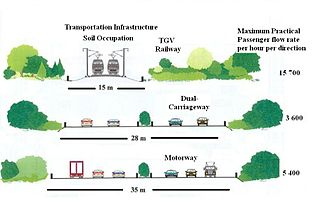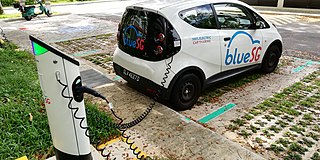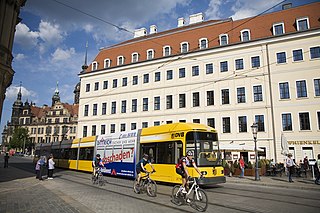Related Research Articles
Ecological modernization is a school of thought that argues that both the state and the market can work together to protect the environment. It has gained increasing attention among scholars and policymakers in the last several decades internationally. It is an analytical approach as well as a policy strategy and environmental discourse.
Eco-capitalism, also known as environmental capitalism or (sometimes) green capitalism, is the view that capital exists in nature as "natural capital" on which all wealth depends. Therefore, governments should use market-based policy-instruments to resolve environmental problems.
Eco-efficiency refers to the delivery of goods and services to meet human needs and improve quality of life while progressively reducing their environmental impacts of goods and resource intensity during their life-cycle.

Environmental technology (envirotech) is the use of engineering and technological approaches to understand and address issues that affect the environment with the aim of fostering environmental improvement. It involves the application of science and technology in the process of addressing environmental challenges through environmental conservation and the mitigation of human impact to the environment.
Technological change (TC) or technological development is the overall process of invention, innovation and diffusion of technology or processes. In essence, technological change covers the invention of technologies and their commercialization or release as open source via research and development, the continual improvement of technologies, and the diffusion of technologies throughout industry or society. In short, technological change is based on both better and more technology.

Sustainable urban infrastructure expands on the concept of urban infrastructure by adding the sustainability element with the expectation of improved and more resilient urban development. In the construction and physical and organizational structures that enable cities to function, sustainability also aims to meet the needs of the present generation without compromising the capabilities of the future generations.

Clean technology, also called cleantech or climatetech, is any process, product, or service that reduces negative environmental impacts through significant energy efficiency improvements, the sustainable use of resources, or environmental protection activities. Clean technology includes a broad range of technology related to recycling, renewable energy, information technology, green transportation, electric motors, green chemistry, lighting, grey water, and more. Environmental finance is a method by which new clean technology projects can obtain financing through the generation of carbon credits. A project that is developed with concern for climate change mitigation is also known as a carbon project.

A sustainable city, eco-city, or green city is a city designed with consideration for social, economic, environmental impact, and resilient habitat for existing populations, without compromising the ability of future generations to experience the same. The UN Sustainable Development Goal 11 defines sustainable cities as those that are dedicated to achieving green sustainability, social sustainability and economic sustainability. They are committed to doing so by enabling opportunities for all through a design focused on inclusivity as well as maintaining a sustainable economic growth. The focus will also includes minimizing required inputs of energy, water, and food, and drastically reducing waste, output of heat, air pollution – CO2, methane, and water pollution. Richard Register, a visual artist, first coined the term ecocity in his 1987 book Ecocity Berkeley: Building Cities for a Healthy Future, where he offers innovative city planning solutions that would work anywhere. Other leading figures who envisioned sustainable cities are architect Paul F Downton, who later founded the company Ecopolis Pty Ltd, as well as authors Timothy Beatley and Steffen Lehmann, who have written extensively on the subject. The field of industrial ecology is sometimes used in planning these cities.
Bright green environmentalism is an ideology based on the belief that the convergence of technological change and social innovation provides the most successful path to sustainable development.

Ecological design or ecodesign is an approach to designing products and services that gives special consideration to the environmental impacts of a product over its entire lifecycle. Sim Van der Ryn and Stuart Cowan define it as "any form of design that minimizes environmentally destructive impacts by integrating itself with living processes." Ecological design can also be defined as the process of integrating environmental considerations into design and development with the aim of reducing environmental impacts of products through their life cycle.
Renewable energy law is a particular kind of energy law, and relates primarily to the transactional legal and policy issues that surround the development, implementation, and commercialization of renewable sources of energy, such as solar, wind, geothermal and tidal. Renewable energy, (RE) law also relates to the land use, siting, and finance issues encountered by developers of renewable energy projects.
This page is an index of sustainability articles.
Information and communication technologies for environmental sustainability is a general term referring to the application of information and communication technologies (ICTs) within the field of environmental sustainability. Information and communication technologies are acting as integrating and enabling technologies for the economy and they profoundly affect our society. Recent changes in ICT use globally have damaged the environment but also have the potential to support environmental sustainability activities, such as the targets set within the Millennium Development Goal (MDG) number 7 (MDG7) to "ensure environmental sustainability".

Micro-sustainability is the portion of sustainability centered around small scale environmental measures that ultimately affect the environment through a larger cumulative impact. Micro-sustainability centers on individual efforts, behavior modification, education and creating attitudinal changes, which result in an environmentally conscious individual. Micro-sustainability encourages sustainable changes through "change agents"—individuals who foster positive environmental action locally and inside their sphere of influence. Examples of micro-sustainability include recycling, power saving by turning off unused lights, programming thermostats for efficient use of energy, reducing water usage, changing commuting habits to use less fossil fuels or modifying buying habits to reduce consumption and waste. The emphasis of micro-sustainability is on an individual's actions, rather than organizational or institutional practices at the systemic level. These small local level actions have immediate community benefits if undertaken on a widespread scale and if imitated, they can have a cumulative broad impact.
Environmentally sustainable design is the philosophy of designing physical objects, the built environment, and services to comply with the principles of ecological sustainability and also aimed at improving the health and comfort of occupants in a building. Sustainable design seeks to reduce negative impacts on the environment, the health and well-being of building occupants, thereby improving building performance. The basic objectives of sustainability are to reduce the consumption of non-renewable resources, minimize waste, and create healthy, productive environments.
Sustainable distribution refers to any means of transportation / hauling of goods between vendor and purchaser with lowest possible impact on the ecological and social environment, and includes the whole distribution process from storage, order processing and picking, packaging, improved vehicle loadings, delivery to the customer or purchaser and taking back packaging.
Lead market is a term used in innovation theory and denotes a country or region which pioneers the successful adoption of an innovative design. It sends signalling effects to other "lag" markets, which in turn helps in triggering a process of global diffusion. Marian Beise, one of the foremost propounders of this theory as it has been understood so far, states: "Innovations that have been successful with local users in lead markets have a higher potential of becoming adopted world-wide than any other design preferred in other countries". Christoph Bartlett and Sumantra Ghoshal have described lead markets as "[…] markets that provide the stimuli for most global products and processes of a multinational company. Local innovations in such markets become useful elsewhere as the environmental characteristics that stimulated such innovations diffuse to other locations". To illustrate a lead market with some examples, Germany can be seen as a lead market for renewable energies and (premium) automobiles, while the United States would suit as a lead market for information technologies including e-commerce.

Ecomodernism is an environmental philosophy which argues that technological development can protect nature and improve human wellbeing through eco-economic decoupling, i.e., by separating economic growth from environmental impacts.
Difficulty of engagement is a notion in the Campbell paradigm, a model of behavior change with person-independent difficulty.
Eco-restructuring is the implication for an ecologically sustainable economy. The principle of ecological modernization establishes the core literature of the functions that eco-restructuring has within a global regime. Eco-restructuring has an emphasis on the technological progressions within an ecological system. Government officials implement environmental policies to establish the industrial- ecological progressions that enable the motion of economic modernization. When establishing economic growth, policy makers focus on the progression towards a sustainable environment by establishing a framework of ecological engineering. Government funding is necessary when investing in efficient technologies to stimulate technological development.
References
- ↑ Díaz-García, Cristina; González-Moreno, Ángela; Sáez-Martínez, Francisco J. (2015). "Eco-innovation: insights from a literature review". Innovation: Management, Policy & Practice. 17 (1): 6–23. doi:10.1080/14479338.2015.1011060. S2CID 142928354.
- ↑ Fussler, C. & P. James, 1996; Driving Eco-Innovation: A Breakthrough Discipline for Innovation and Sustainability, Pitman Publishing: London, 364 p.
- 1 2 James, P., 1997; 'The Sustainability Circle: a new tool for product development and design', Journal of Sustainable Product Design 2: 52:57, http://www.cfsd.org.uk/journal
- ↑ Rennings, Klaus (2000). "Redefining innovation - eco-innovation research and the contribution from ecological economics". Ecological Economics. 32 (2): 319–332. doi:10.1016/S0921-8009(99)00112-3.
- ↑ Carrillo-Hermosilla, J., del Rio, P. & Könnölä, T., 2009; Eco-Innovation: When Sustainability and Competitiveness Shake Hands, Palgrave Mcmillan: Hampshire, 256 p.
- ↑ Karakaya, Emrah; Hidalgo, Antonio; Nuur, Cali (2014). "Diffusion of eco-innovations: A review". Renewable and Sustainable Energy Reviews. 33: 392–399. doi:10.1016/j.rser.2014.01.083.
- ↑ Kowalska-Pyzalska, A. (2015). "Social acceptance of green energy and dynamic electricity tariffs — A short review". 2015 Modern Electric Power Systems (MEPS) (PDF). pp. 1–7. doi:10.1109/MEPS.2015.7477192. ISBN 978-1-5090-3101-6. S2CID 24787410.
- ↑ Devine-Wright, Patrick, ed. (2011). Renewable energy and the public: from NIMBY to participation. Taylor & Francis.
- ↑ Gyamfi, Samuel; Krumdieck, Susan; Urmee, Tania (2013). "Residential peak electricity demand response—Highlights of some behavioural issues". Renewable and Sustainable Energy Reviews. 25: 71–77. doi:10.1016/j.rser.2013.04.006.
- ↑ Byrka, Katarzyna; Jȩdrzejewski, Arkadiusz; Sznajd-Weron, Katarzyna; Weron, Rafał (2016). "Difficulty is critical: The importance of social factors in modeling diffusion of green products and practices". Renewable and Sustainable Energy Reviews. 62: 723–735. doi:10.1016/j.rser.2016.04.063.
- ↑ M., Rogers, Everett (2003). Diffusion of innovations. Free Press. ISBN 0-7432-2209-1. OCLC 439992230.
{{cite book}}: CS1 maint: multiple names: authors list (link) - 1 2 Abadzhiev, Andrey; Sukhov, Alexandre; Sihvonen, Antti; Johnson, Mikael (2022-01-01). "Managing the complexity of green innovation". European Journal of Innovation Management. 25 (6): 850–866. doi: 10.1108/EJIM-02-2022-0098 . ISSN 1460-1060. S2CID 250572350.
